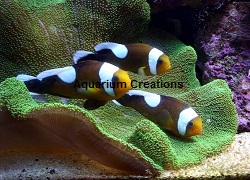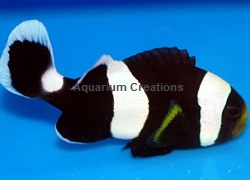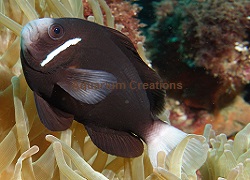ORA® Captive Bred
Brown Saddleback Clownfish
Amphiprion polymnus

Identification:The Brown Saddleback Clownfish has an orange-brown body with a vertical white band behind their head, and a large white patch on their doral area which resembles a "saddle". Hence the name Brown Saddleback Clownfish. Captive bred A. polymnus are hardy in aquariums. They have an unusual “bobbing up and down” swimming motion, which is quite distinctive of the Saddleback Clownfish. The Brown Saddleback Clownfish nest averages about 500 eggs, and they can spawn twice a month. It doesn't need an Anemone to survive, but will accept Long Tentacle and Carpet Anemones
as its host, as well as many corals.
Benefits of purchasing captive bred:
The most important benefit is that by purchasing tank bred fish you are protecting
the oceans of the world from destruction. Further benefits are just as important. Tank bred fish are hardier than their wild caught counterpart and additionally
very accustomed to aquarium life and very accustomed to aquarium food.
Minimum tank size:
20 Gallon
Feeding and diet:
All clownfish are omnivores, meaning they need to eat both meaty foods along with some greens in their diet.
A high quality marine flake food, rich in spirulina and algae, as well as freeze dried and frozen foods are readily accepted and will provide the nutrition they need.
Reef Compatibility:
Excellent Reef Fish
Level of Care:
Easy
>
Acclimation Time:
3+ hours
Acclimation
Time: 3+
hours
Approximate Purchase Size:
1-1/2" to 2"
|
$24.99
|
ORA® Captive Bred
Black Saddleback Clownfish
Amphiprion polymnus

Identification:The Black Saddle Clownfish is a less common form of Amphiprion polymnus, the same species as the common brown saddle back clownfish. Unlike the more commonly available Brown Saddleback Clownfish, the Black Saddleback Clownfish is deep black and the second bar actually forms a bar that reaches almost completely across the entire body instead of forming a saddle. Read more: http://reefbuilders.com/tag/black-saddle-clownfish/#ixzz1yxbTvQj1
Aquarium specimens have been observed becoming lighter or darker after accepting a new host anemone species, sometimes within a few hours. In some varieties, typically those specimens initially associated with H. crispa anemone[1], the saddle shape may extend up onto the fish's Dorsal fin with a third white bar or margin located across the caudal peduncle. An excellent candidate for a small group of Black Saddleback's, maybe in a host anemone if your lighting will support it.
Minimum tank size:
30 Gallon
Feeding and diet:
All clownfish are omnivores, meaning they need to eat both meaty foods along with some greens in their diet.
A high quality marine flake food, rich in spirulina and algae, as well as freeze dried and frozen foods are readily accepted and will provide the nutrition they need.
Reef Compatibility:
Excellent Reef Fish
Level of Care:
Easy
Acclimation Time:
2+ hours
Approximate Purchase Size:
Small: 3/4" to 1-1/4" Medium: 1-1/4" to 2"; Large: 2" to 3"
|
Small$29.99
Medium$37.99
Large$49.99
Mated Pairs Available$109.99
|
ORA® Very Hard to Find!
McCullochi Clownfish
Amphiprion ocellaris sp.

Identification:
The ORAŽ Captive Bred McCullochi Clownfish is one of the hardest to find fish in the aquarium industry because the McCullochi Clownfish is native to Lord Howe Island off the coast of Australia. Its tiny natural range is closed to fishing making it one of the rarest Clownfish in the aquarium hobby. The McCullochi has a beautiful coloration ranging from Tobacco Brown to a Smoky Ash Black that sets off the brightest white tail and a single white head bar. Juveniles tend to be more brown in coloration and have three bars. Maximum size in the wild is 6 inches for this rare one but in an aquarium their maximum size is only 4-1/2 inches.
Benefits of purchasing captive bred:
The most important benefit is that by purchasing tank bred fish you are protecting
the oceans of the world from destruction. Further benefits are just as important. Tank bred fish are hardier than their wild caught counterpart and additionally
very accustomed to aquarium life and very accustomed to aquarium food.
Minimum tank size:
70 Gallon
Feeding and diet:
All clownfish are omnivores, meaning they need to eat both meaty foods along with some greens in their diet.
A high quality marine flake food, rich in spirulina and algae, as well as freeze dried and frozen foods are readily accepted and will provide the nutrition they need.
Reef Compatibility:
Excellent Reef Fish
Level of Care:
Moderate
Acclimation Time:
3+ hours
Approximate Purchase Size:
1" to 1-1/2"
|
$99.99
|




